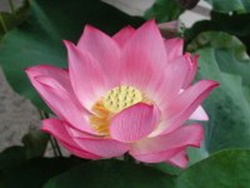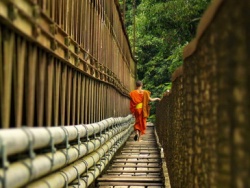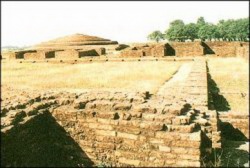Voice-hearer
voice-hearer (śrāvaka, 聲聞). One who has received oral teachings from the Buddha. Those who follow only His teachings preserved in the Hīnayāna Canon recognized by the Theravāda School are present-day voice-hearers. Listed below are a few disciples of the Buddha:
Ājñātakauṇḍinya (阿若憍陳如) was one of the first five disciples of the Buddha. He is well regarded as an Elder.
Ānanda (阿難) was the younger brother of Devadatta. As the Buddha’s attendant, he is noted for hearing and remembering all the teachings of the Buddha. Ānanda became an Arhat after the Buddha’s parinirvāṇa. In the first assembly of Arhats, he recited from memory all the teachings for the compilation of the sūtras. Succeeding Mahākāśyapa, he is reckoned as the second patriarch of the Buddhist lineage.
Aniruddha (阿那律) became a disciple soon after the Buddha’s enlightenment. He used to fall asleep when the Buddha was teaching and was reproved by the Buddha. Ashamed, he practiced day and night without sleep and lost his eyesight. However, he was able to see with his god-eye.
Cullapatka (周梨槃陀迦), also called Śuddhipanthaka, and his twin brother, Patka (Panthaka), were born on a roadside while their parents were traveling. He was forgetful of the Buddha’s teachings. Then the Buddha told him to remember the short phrase “remove the dust and filth” as he did cleaning work in his daily life. He then attained Arhatship and transcendental powers.
Devadatta (提婆達多) was a cousin of the Buddha, with whom he had competed since childhood. He became a disciple after the Buddha had attained perfect enlightenment. He trained hard for twelve years but did not attain Arhatship. Disgusted, he studied magic and formed his own group. Devadatta beat a nun to death and made several attempts to murder the Buddha and destroy the Saṅgha. He fell into hell after his death. However, in a previous life he had given the Buddha Mahāyāna teachings. Despite the wicked deeds in his life, the Buddha prophesies in the Lotus Sūtra (T09n0262) that Devadatta will become a Buddha called Devarāja.
Gavāṁpati (憍梵波提) had been a cow for 500 lives because of his past karma. As a disciple of the Buddha, he still ruminated like a cow, and he was mocked by people as the cow-faced bhikṣu. Out of compassion, the Buddha sent him to a garden in Trayastriṁśa Heaven to train in meditation. He returned to Earth after the Buddha’s parinirvāṇa, and he too entered parinirvāṇa soon afterward.
Kālodāyin (迦留陀夷) was a disciple whose skin was very black. He used to beg for food at night. A pregnant woman miscarried when she saw him in a flash of lightning in the dark of the night. Then the Buddha stipulated that no one should beg for food after noontime.
Kapphiṇa (劫賓那) was born under the constellation Scorpio. He is said to have understood astronomy, been the king of Southern Kauśala, and then become a disciple of the Buddha, receiving his monastic name Mahākapphiṇa. In the Lotus Sūtra (T09n0262), the Buddha prophesies that Kapphiṇa will become a Buddha called Samanta-prabhāsa.
Kāśyapa brothers (三迦葉) were Uruvilvākāśyapa (優樓頻螺迦葉), Nadīkāśyapa (那提迦葉), and Gayākāśyapa (伽耶迦葉). Initially fire-worshippers, they joined the Buddha’s Order together with their 1,000 followers.
Mahāculla (摩訶周那), also called Patka, Panthaka, or Mahāpanthaka, was the elder twin brother of Cullapatka. More intelligent than his twin, he soon attained Arhatship after joining the Buddha’s Order.
Mahākāśyapa (摩訶迦葉) was initially a Brahmin in Magadha. He became a disciple three years after the Buddha had attained enlightenment. In eight days, Mahākāśyapa attained Arhatship. He is considered foremost in ascetic practices. When the Buddha held up a flower, only Mahākāśyapa in the huge assembly understood the meaning and responded with a smile (X01n0027, 0442c16–21). Then the Buddha entrusted him with the continuation of the lineage, and he became the first patriarch after the Buddha’s parinirvāṇa. After entrusting the lineage to Ānanda, Mahākāśyapa went to the Vulture Peak (Gṛdhrakūṭa) Mountain. There he has remained in samādhi. He will enter parinirvāṇa after the advent the next Buddha, Maitreya.
Mahākātyāyana (摩訶迦旃延) was born into the Brahmin caste in the kingdom of Avanti in western India. He studied the Vedas under his uncle Asita, a ṛṣi, who foresaw that Prince Siddhārtha would attain Buddhahood. Mahākātyāyana then followed the Buddha in honor of Asita’s death wish. Through diligent training under the Buddha, Mahākātyāyana attained Arhatship. After the parinirvāṇa of the Buddha, he often debated with non-Buddhists, and is considered foremost in polemic.
Mahākauṣṭhila (摩訶拘絺羅) joined the Buddha’s Order after his nephew Śāriputra did. He soon attained Arhatship and acquired unimpeded eloquence. The Buddha praised him as foremost in eloquence.
Mahāmaudgalyāyana (大目揵連), together with his own disciples, following his good friend Śāriputra, became a disciple of the Buddha and attained Arhatship in a month. Śāriputra is portrayed as standing on the Buddha’s right, with Maudgalyāyana on His left. Maudgalyāyana was stoned to death by Brahmins shortly before the Buddha’s parinirvāṇa. He is considered foremost in transcendental powers.
Nanda (難陀). (1) Nanda was the half brother of the Buddha. He was also called Sundara-Nanda (孫陀羅難陀), with his wife’s name Sundarī added to differentiate him from Nanda the Cattle Herder. He was tall and handsome, with thirty marks of a great man. After becoming a monk under the Buddha, he was still attached to his wife. Through the Buddha’s skillful teachings, he ended his love and desire and attained Arhatship. (2) Nanda was the Cattle Herder who offered milk every day to the Buddha and His disciples during their three-month summer retreat. Assuming that the Buddha knew nothing about cattle herding, he asked Him questions. After the Buddha told him eleven things about cattle herding, Nanda was deeply moved and joined the Buddha’s Order.
Patka (半託迦), also called Panthaka or Mahāpanthaka, was the elder twin brother of Cullapatka. More intelligent than his twin, he was accomplished in the five studies. He attained Arhatship soon after joining the Buddha’s Order.
Piṇḍola-Bharadvāja (賓頭盧頗羅墮) is also called the Long-Eyebrowed Arhat, and Bharadvāja is one of the six famous family names of Brahmins. He is one of the sixteen great Arhats who remain in the world for various reasons. Piṇḍola was the son of a state minister and attained Arhatship at a young age. However, after he flaunted his transcendental powers, the Buddha rebuked him and forbade him to enter parinirvāṇa. So he is still in the world, delivering sentient beings.
Pūrṇa (富樓那) is also called Pūrṇa-Maitrāyaṇīputra, under his mother’s family name Maitrāyaṇī. He was the son of a minister of King Śuddhodana of the kingdom of Kapilavastu. He was very intelligent, and studied the Vedas at a young age. On the night Prince Siddhārtha left the palace to seek the truth, he too left with thirty friends to practice asceticism in the snow mountain. He attained the four dhyānas and the five transcendental powers. After Siddhārtha attained Buddhahood and did the first turning of the Dharma wheel in Deer Park, he became a monk in the Buddha’s Order and soon attained Arhatship. He is considered foremost in expounding the Dharma because some 99,000 people were delivered through his teachings.
Rāhula (羅睺羅) was the only son of Śākyamuni Buddha and Yaśodharā. He had been in gestation for six years and was born on the lunar eclipse after the Buddha had attained perfect enlightenment. Rāhula was six years old when the Buddha returned to the city kingdom of Kapilavastu, and he became a novice monk at the command of the Buddha. Foremost in secret training, he is to be reborn as the eldest son of every future Buddha.
Revata (離婆多) is the younger brother of Śāriputra. In his meditation at a temple, he saw two ghosts fighting to eat a corpse. Realizing the illusoriness of the body, he renounced family life and became a disciple of the Buddha. Traveling barefoot in a snow country, his feet were frostbitten. The Buddha praised him for his contentment with few material things and allowed him to wear shoes.
Śāriputra (舍利弗), together with his own disciples, joined the Buddha’s Order soon after the Buddha’s enlightenment. After being a principal disciple for forty-four years, to avoid his grief over the Buddha’s parinirvāṇa, he requested and received the Buddha’s permission to enter parinirvāṇa sooner than the Buddha. He is considered foremost in wisdom among the disciples.
Subhūti (須菩提) is the foremost among the disciples in understanding the meaning of emptiness. He is the principal interlocutor in the Prajñā-Pāramitā Sūtra.
Svāgata (莎伽陀). In the Buddha Pronounces the Sūtra of the Bhikṣu Svāgata’s Merit (T14n0501), this bhikṣu named Svāgata lay drunk under a tree. The Buddha praised his merit for subjugating a vengeful dragon and explained that Svāgata was not really drunk but pretended drunkenness for a purpose.
Upāli (優波離) had been a barber in the royal court. He became a disciple, together with Ānanda, six years after the Buddha had attained perfect enlightenment. Foremost in observing the precepts, he contributed to the compilation of the Vinaya in the first assembly of the Arhats after the Buddha’s parinirvāṇa.
Upananda (跋難陀) and his brother Nanda (難陀) often caused disciplinary problems. Because of their misconduct, the Buddha had to add a few more precepts to the collection. Upananda rejoiced over the Buddha’s parinirvāṇa because in his opinion it freed the disciples from restraint.
Vakkula (薄拘羅), or Vakula, was a disciple who lived to age 160 without a moment’s illness or pain.



